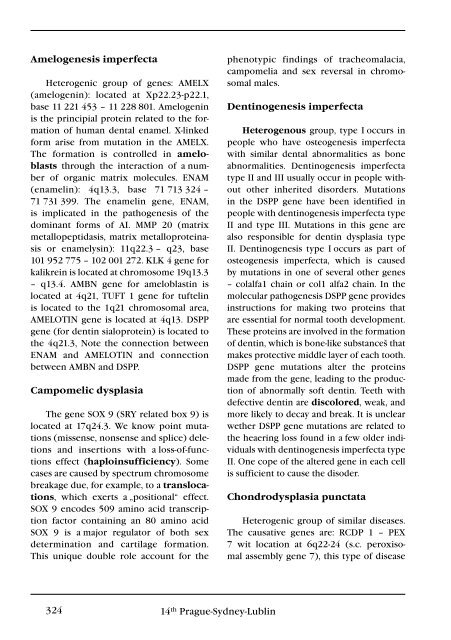3+4+Supplementum/2012 - Společnost pro pojivové tkáně
3+4+Supplementum/2012 - Společnost pro pojivové tkáně
3+4+Supplementum/2012 - Společnost pro pojivové tkáně
- TAGS
- www.pojivo.cz
You also want an ePaper? Increase the reach of your titles
YUMPU automatically turns print PDFs into web optimized ePapers that Google loves.
amelogenesis imperfecta<br />
Heterogenic group of genes: AMELX<br />
(amelogenin): located at Xp22.23-p22.1,<br />
base 11 221 453 – 11 228 801. Amelogenin<br />
is the principial <strong>pro</strong>tein related to the formation<br />
of human dental enamel. X-linked<br />
form arise from mutation in the AMELX.<br />
The formation is controlled in ameloblasts<br />
through the interaction of a number<br />
of organic matrix molecules. ENAM<br />
(enamelin): 4q13.3, base 71 713 324 –<br />
71 731 399. The enamelin gene, ENAM,<br />
is implicated in the pathogenesis of the<br />
dominant forms of AI. MMP 20 (matrix<br />
metallopeptidasis, matrix metallo<strong>pro</strong>teinasis<br />
or enamelysin): 11q22.3 – q23, base<br />
101 952 775 – 102 001 272. KLK 4 gene for<br />
kalikrein is located at chromosome 19q13.3<br />
– q13.4. AMBN gene for ameloblastin is<br />
located at 4q21, TUFT 1 gene for tuftelin<br />
is located to the 1q21 chromosomal area,<br />
AMELOTIN gene is located at 4q13. DSPP<br />
gene (for dentin sialo<strong>pro</strong>tein) is located to<br />
the 4q21.3, Note the connection between<br />
ENAM and AMELOTIN and connection<br />
between AMBN and DSPP.<br />
Campomelic dysplasia<br />
The gene SOX 9 (SRY related box 9) is<br />
located at 17q24.3. We know point mutations<br />
(missense, nonsense and splice) deletions<br />
and insertions with a loss-of-functions<br />
effect (haploinsufficiency). Some<br />
cases are caused by spectrum chromosome<br />
breakage due, for example, to a translocations,<br />
which exerts a „positional“ effect.<br />
SOX 9 encodes 509 amino acid transcription<br />
factor containing an 80 amino acid<br />
SOX 9 is a major regulator of both sex<br />
determination and cartilage formation.<br />
This unique double role account for the<br />
324 14 th Prague-Sydney-Lublin<br />
phenotypic findings of tracheomalacia,<br />
campomelia and sex reversal in chromosomal<br />
males.<br />
dentinogenesis imperfecta<br />
Heterogenous group, type I occurs in<br />
people who have osteogenesis imperfecta<br />
with similar dental abnormalities as bone<br />
abnormalities. Dentinogenesis imperfecta<br />
type II and III usually occur in people without<br />
other inherited disorders. Mutations<br />
in the DSPP gene have been identified in<br />
people with dentinogenesis imperfecta type<br />
II and type III. Mutations in this gene are<br />
also responsible for dentin dysplasia type<br />
II. Dentinogenesis type I occurs as part of<br />
osteogenesis imperfecta, which is caused<br />
by mutations in one of several other genes<br />
– colalfa1 chain or col1 alfa2 chain. In the<br />
molecular pathogenesis DSPP gene <strong>pro</strong>vides<br />
instructions for making two <strong>pro</strong>teins that<br />
are essential for normal tooth development.<br />
These <strong>pro</strong>teins are involved in the formation<br />
of dentin, which is bone-like substanceš that<br />
makes <strong>pro</strong>tective middle layer of each tooth.<br />
DSPP gene mutations alter the <strong>pro</strong>teins<br />
made from the gene, leading to the <strong>pro</strong>duction<br />
of abnormally soft dentin. Teeth with<br />
defective dentin are discolored, weak, and<br />
more likely to decay and break. It is unclear<br />
wether DSPP gene mutations are related to<br />
the heaering loss found in a few older individuals<br />
with dentinogenesis imperfecta type<br />
II. One cope of the altered gene in each cell<br />
is sufficient to cause the disoder.<br />
Chondrodysplasia punctata<br />
Heterogenic group of similar diseases.<br />
The causative genes are: RCDP 1 – PEX<br />
7 wit location at 6q22-24 (s.c. peroxisomal<br />
assembly gene 7), this type of disease

















